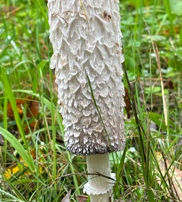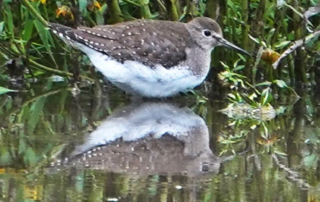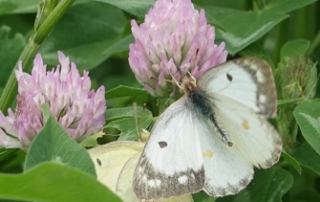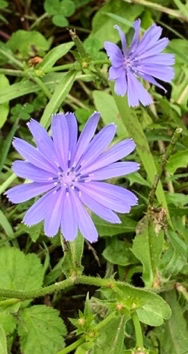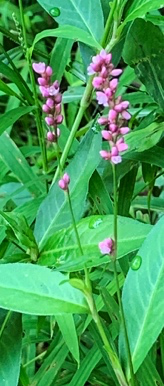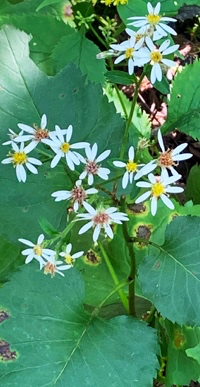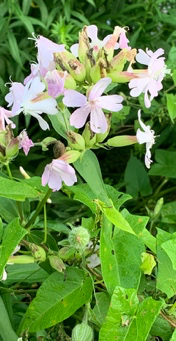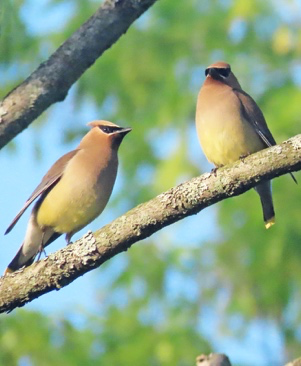Ernest Williams Nature Observations – May 1 2025

This is an exciting time of year as we watch spring rapidly unfold. All the photos here are from this week, with the highlighted species appearing right on schedule. White trillium and marsh marigold have burst forth in the past 3 days, particularly between the pond (distance marker #10) and the glade (#14). See the photo to the right. Violets, foamflower, and wild ginger are newly open, and shadbush, a small tree (so named because it flowers when the shade are running), is in flower (it’s also known as serviceberry).
With birds, new spring migrants are appearing daily; the last two days on the trail have brought yellow warbler, common yellowthroat, chestnut-sided warbler, great crested flycatcher, and Baltimore oriole, while ruby-crowned kinglet and house wren appeared a few days earlier. The pond always has surprises (three shown here). Bluebirds investigated the bluebird boxes just north of Dugway Rd, but tree swallows have take n over nesting in all four. You can watch swallows fly in and out of the boxes.
Don’t overlook other kinds of wildlife, too, such as emerald green tiger beetles and cabbage white butterflies along the trail and painted turtles sunning at the pond margins. Keep your eyes open; every week is different.

Ernest Williams Nature Observations – October 1, 2024
 The one-mile trail north of Dugway Rd is now ready! We will celebrate the completion of this part of the trail at 3:00 pm, Tuesday, Oct. 1. Take a walk and see what you can find. Some habitats here differ from those found along the trail south of Dugway, which means some different nature sightings.
The one-mile trail north of Dugway Rd is now ready! We will celebrate the completion of this part of the trail at 3:00 pm, Tuesday, Oct. 1. Take a walk and see what you can find. Some habitats here differ from those found along the trail south of Dugway, which means some different nature sightings.
Late season always brings out a wonderful diversity of asters and goldenrods, as shown below, and there are more species in each group than are shown below (8 asters, 4 goldenrods). We still find occasional flowers that we’ve been seeing since earlier in the summer such as soapwort, evening primrose, and pale and spotted jewelweed, though they are now fewer in number. The subtle and camouflaged appearance of beech drops belies their presence, but you’ll find them near beech trees because, rather than being photosynthetic, they are parasitic on beech roots. Mushrooms and other fungi are emerging, too; see the shaggy mane shown here. This is also a season of seeds and fruits, of course, some of which are colorful to attract
birds to disperse the plant’s seeds. Finding wild hops along the trail is a reminder of this region’s importance long ago in hops production.
The edges of the pond often conceal surprises, so look beyond any ducks and geese that may be on the water, and you may find a (very attractive) solitary sandpiper as I did 2 days ago. This nature update is the last of 2024, but keep looking along the trail. What new sightings will we find next year?
Ernest Williams Nature Observations – September 1, 2024
More than 50 plant species are in flower and fruit along the trail now, and below is just a selection of what you can find. This is the time of greatest diversity of flowering species and of floral shape (different kinds of pollinators are attracted to different floral characteristics). One of the flowering plants is spotted knapweed, which may look pretty but is a nasty invasive that crowds out native plants; feel free to kill it. Birds on the trail currently include mostly common species (chickadee, robin, catbird, crow, Carolina wren, goldfinch, woodpeckers), but we’re seeing many of the young produced this year. A wood duck family has stayed regularly at the pond. Sulphur butterflies are now numerous in the fields by Dugway Rd, and in the photo below, a male sulphur underneath is trying to mate with the female above (some females are white rather than yellow). Beautiful, freshly emerged question mark butterflies are out, showing why in the 1800s they were called violet-tips. Of course this is a season of fruit production, with red, black, and white berries, as well as other fruiting structures, providing food to birds and other animals in exchange for seed dispersal.
E.H.Williams Nature Observations – October 1st, 2023
This final nature update for 2023 and all photos are from my walking the trail the morning of Sep 29. A standard set of birds was present – goldfinch, song sparrow, catbird, robin, crow, jay, chickadee, dove, red-bellied wp, flicker – but also a Carolina wren and female/young indigo bunting. The pond always has activity, this morning including a heron, mallards, and wood ducks. Nice to see the two duck species together; wood ducks are clearly smaller.
Asters along with a late goldenrod – shown below – dominate the flowers along the trail, and they are wonderful at this time of year. Evening primrose, brown-eyed susan, and both jewelweeds continue to flower, and gaura is a late addition. The only colorful fruit I saw was that of multiflora rose, an invasive non-native.
The beginning of the trail has a nice assemblage of plants that, a result of a lot of work, is replacing the Japanese knotweed. The trail is a wonderful place for a fall walk.
![]()
E.H.Williams Nature Observations – September 1st, 2023
The trail is now providing a mix of late summer and fall sightings. It’s a season with asters, goldenrods, and numerous other flowers, some of which have just opened and some of which have been flowering for many weeks (e.g., soapwort, daisy, knapweed). You’ll see three closely-related aster family plants: boneset, joe-pye-weed, and snakeweed (trivia note: Joe Pye was a Mohican chief who used this plant as a curative). It’s also a season of fruits and seeds; look for the conspicuous fruits of red baneberry, chokecherry, pokeweed, doll’s eyes, and wild grape. Animals consume the fruits, and the seeds are then dispersed by passing through the animals. With hooks on its seeds, burdock provides a mechanical form of seed dispersal by attaching to passing mammals. Jewelweed is also called touch-me-not because its ripe pods fly apart when touched (“explosive dehiscence”), yet another form of seed dispersal.
Birds are less obvious now than they have been for most of the summer, but the pond often provides surprises; this morning (Aug 30) I found a kingfisher, GB heron, and 3 wood ducks, and several days ago I saw a solitary sandpiper. Monarch caterpillars have been scarce along the trail this summer – all monarchs should be migrating southward now – but you can still find fuzzy caterpillars of the milkweed tussock moth on partially eaten milkweed leaves. You’ll also find hops along the trail, thus providing a connection to the region’s history of hops production. Don’t wait to take a nature walk; the growing season is clearly passing.

E.H.Williams Nature Observations – August 1st, 2023
All the photos below were from the trail this morning, July 31 (except the wood ducks, flicker, and oriole). Birds seem less numerous now, but yellow warblers, yellowthroats, catbirds, and song sparrows are always apparent. Newly obvious are juvenile birds; the song sparrow, indigo bunting, and Baltimore oriole below are examples of young birds, and so, of course, are the wood duck ducklings from earlier this month.
New flowers appear every week. Queen Anne’s lace and soapwort are now abundant, but a number of new and different yellow flowers add color to the trail edges, as does beebalm (Monarda) in lavender, red, and purple shades. Don’t be too attracted to the purple of spotted knapweed; it’s a noxious and damaging invasive. But Indian pipe is an unobtrusive late season native flower – white and waxy because it’s a non-photosynthesizing saprophyte that takes in nutrients from decaying organic matter. See if you can find any!
Late summer means that fruits are developing, too. Honeysuckle fruit are obvious, but you can find grapes and others. Note that brightly colored fruit are conspicuous, all the better to be found and consumed so that their seeds are spread far and wide. The burs of burdock (nature’s Velcro) provide another form of seed dispersal.













